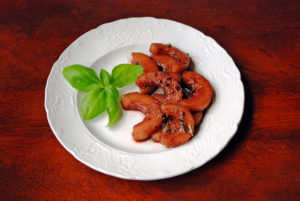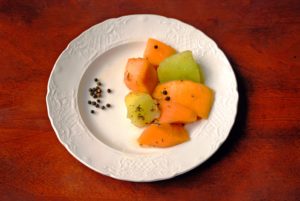This post recounts the results of an experiment that took place recently between me and my husband. In the Apician cookbook there are two recipes very close together that can be used for either cucumbers or melons:
PEPPER, PENNYROYAL, HONEY OR CONDENSED MUST, BROTH AND VINEGAR; ONCE IN A WHILE ONE ADDS SILPHIUM. (Apicius III.6.3 (for cucumbers) and III.7.1 (for melons))
Ingredients are listed, but no amounts are offered. My husband, who is also a good cook, wanted to join me in the cookoff. So I proposed using our different takes on the cucumber-melon Apician recipe to demonstrate the role of variation in Roman cooking. We cooked our dishes separately, and did not compare notes until after the experiment was over. Interestingly, we came up with radically different dishes based on the same ancient recipe. The results follow.
__________
Apician Cucumbers by Laura Kelley
This is a slightly sour starter salad or condiment in a large meal that has the unusual flavor of red wine must and vinegar as the main flavors. The pennyroyal sweetens the mixture just a bit and the asafetida adds a bit of depth. The garum of course is the umami factor for this unusual combination of flavors.
Ingredients
1-2 large western cucumbers (or multiple smaller Asian ones)
Dressing
3 teaspoons dried, shredded pennyroyal
2 teaspoons coarsely ground black peppercorns
2 tablespoons beef broth
2 tablespoons olive oil
2 tablespoons red wine vinegar
3-4 teaspoons reduced red wine *
4 teaspoons garum
1-2 pinches asafetida (optional)
Prepare the dressing by whisking all of the ingredients together in a shallow bowl or cup. If you are sensitive to textures, you may wish to grind the pennyroyal into a powder. Peel, deseed and cut the cucumbers crosswise. Pour dressing over the cucumbers and mix well. Refrigerate for at least 1 hour. When about to serve, add the asafetida if desired, and mix well. Serve cool, not cold or at room temperature.

* Reduced wine or must is very simple to make. For reduced wine, simply heat wine to a near boil, then turn down the flame to low or medium low and cook very gently – stirring often – until light syrup is formed. For reduced must, use procedure above on commercially available 100% grape juice – unless you live near a vineyard and can get a large amount of fresh must. Best if prepared at least one day before cooking and allowed to fully cool before using. Stores for months if refrigerated in a sterilized, sealed glass jar. 1.5 liters of wine makes about ¼ to 1/3 cup of must. (Reduced wine and must carry a wallop of sweet and sour flavor and should be used cautiously, or they will easily overpower and recipe.)
__________
Apician Melons by Stephen Kelley
This melon recipe is surprisingly sweet given the addition of so much white vinegar. It provides a delicious and remarkable dessert or sweet snack of melons flavored in an unusual way – with sweet pennyroyal and lots of black pepper. Best when served cool or room temperature – but not cold.
Ingredients
½ honeydew melon
½ cantaloupe
Dressing
3 teaspoons dried, shredded pennyroyal
2½ teaspoons coarsely ground black peppercorns
6 teaspoons white vinegar
6 teaspoons reduced white wine
4 teaspoons garum
Prepare the dressing by whisking all of the ingredients together in a shallow bowl or cup. If you are sensitive to textures, you may wish to grind the pennyroyal into a powder. Peel, deseed and dice the melons and mix them together. Pour dressing over the melons and mix well. Refrigerate for at least 1 hour. Serve cool, not cold or at room temperature.
__________
First off, let me say that both dishes were delicious. We were both surprised to see what different dishes we made from the same list of ingredients. As you can see, to some degree, our preconceived notions about what to do with the main ingredient greatly influenced our choices. Working with the cucumber, I went for a more sour, salad-like dish, and my husband went the dessert route because he was working with melons.
We both used reduced wine instead of reduced must (which would usually be slightly sweeter) or honey because that is what we had on hand.

We were also impressed by the absence of any fish flavor on the vegetables and fruits despite a fair amount of garum added to each dressing. I am not a big fan of dishes with a strong flavor of alcohol in them and particularly dislike rum cakes and tipsy parsons. That said, however, the rich flavor of reduced wine on the cucumbers and melons was fantastic and I urge you to try it.
Those of you who follow this blog will know that I pay a lot of attention to variation in Asian “recipes” many of which are offered as rudimentary lists of ingredients, just as the Roman recipe above. To sum up some of the posts I’ve written on variation, which are available here and here, I’d note that most of the rest of the world doesn’t care about the uniformity that so many in the west desire.
For example, many recipes in Central or Western Asia are given with the ingredient, “greens”. Most of the time this could be cilantro, parsley, tarragon, dill or even one of the savories – the varying balance of which could drastically change the flavor of a dish. A modern western version of such a recipe would, on the other hand, report the exact amounts of the herbs needed and the form in which to add them. This would lead to a single taste for the recipe, instead of a range of variation. A loss, indeed.
When Asians without formal culinary training are queried about how much of an herb is needed in a recipe, most don’t even understand the question. They shrug and say something like, “however much you wish”.
I find it interesting that many Roman recipes work like many modern Asian ones. We found out in the Mesopotamian cookoff that some dishes – like mersu – could take on many different forms by mixing and matching ingredients according to the diners likes and dislikes, wishes of the cook, their skills, and what they had on hand. Both ancient and modern recipes are part of the legacy of the Silk Road which still influences our world today.
(Words by Laura Kelley; Recipes by Stephen and Laura Kelley as noted, and Photographs of the Apician Cucumbers and Melons by Laura Kelley).

1 thought on “Variation in Roman Cooking: The Tale of the Cucumber and the Melon”